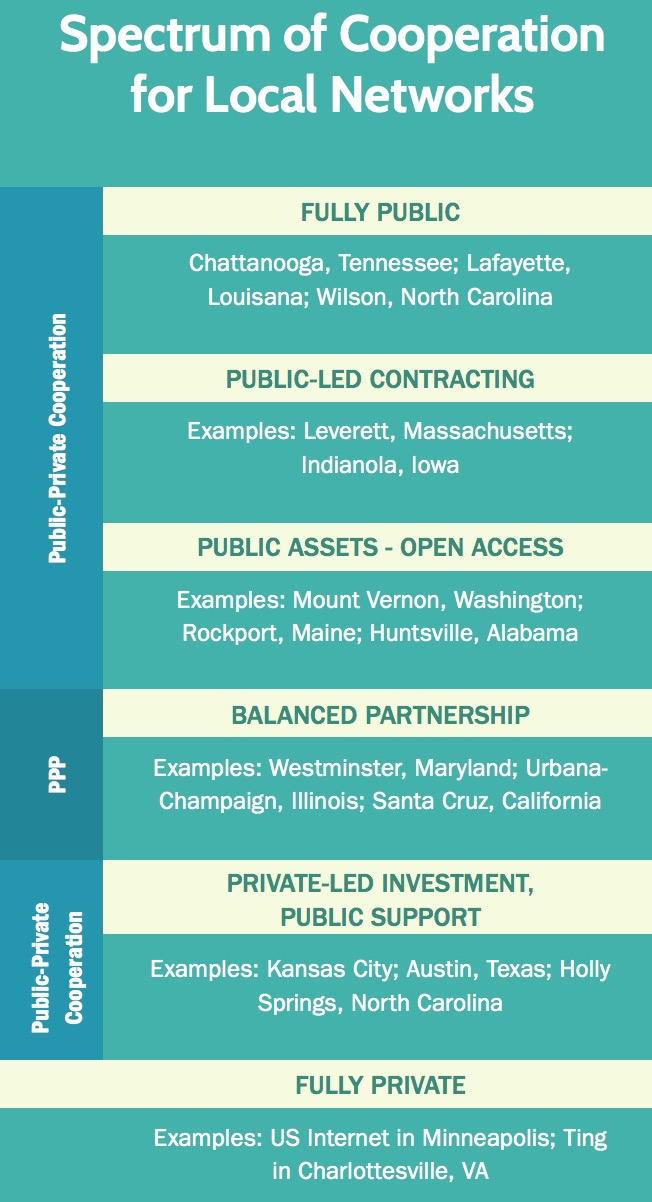INSTITUTE FOR LOCAL SELF-RELIANCE
Written by Patrick Lucey and Christopher Mitchell
Executive Summary
The transition from last generation basic broadband networks to next-generation fiber-optic networks is underway. The rise of municipal gigabit networks, Google Fiber cities, and many small entrepreneurial firms offering fast, low cost Internet access has forced major incumbents like AT&T and CenturyLink to upgrade their networks in a small number of cities.
But most Americans continue to only have one option for high-speed Internet access, according to the Federal Communications Commission, often a cable network with limited upload speeds. Smart cities are realizing they need to act or risk being left behind. However, many do not want to embrace the purely municipal model, where the city would engage in direct competition with existing providers.
One way for those communities to move forward is with a public-private partnership (PPP). But for all the excitement around this model, there are few concrete examples from which to draw lessons.
 This paper explores lessons from PPPs and offers in-depth case studies of three high profile models: Westminster and Ting in Maryland, UC2B and iTV-3/CountryWide in Illinois, and LeverettNet in Massachusetts.
This paper explores lessons from PPPs and offers in-depth case studies of three high profile models: Westminster and Ting in Maryland, UC2B and iTV-3/CountryWide in Illinois, and LeverettNet in Massachusetts.
Westminster is building a citywide fiber network and leasing it to Ting, a relative newcomer to wired networks. Ting will operate the network and has an initial period of exclusivity, after which it will continue to be an ISP but also operate the network on an open access basis. Westminster owns the network, ensuring it will continue to meet local needs.
The Illinois cities of Urbana and Champaign built a core network called UC2B and leased it to a local provider iTV-3 to expand it citywide. But one year later a company named CountryWide announced it was buying iTV-3. Urbana and Champaign had written a right of first refusal into the contract with iTV-3, which gave them some leverage in the transition even though they decided not to use it.
Leverett had similar concerns as Westminster and UC2B regarding the challenges of operating a municipal network but used a series of bids and contracts to maintain local control while leaving key responsibilities to the private sector. The city sets the prices and has achieved a stunning 80 percent take rate.
Each of these approaches offers important lessons from how to set community expectations, define goals, negotiate with partners, and address common challenges. This paper identifies the key elements that allowed the communities to achieve their policy goals, from universal access to requiring that ISPs have humans answering the phone rather than automated systems.
A key lesson from the paper is that PPPs are increasingly viable but are not a panacea, which is why we discuss some failed PPPs. Partnerships can introduce additional risks while minimizing others.
Communities engaging in a PPP should retain some agency for future decision-making. Westminster, Leverett, Santa Cruz, and others own part of the network to retain that control. They have each spent tremendous effort educating the community and demonstrating support.
Finally, any PPP has risks and communities should be extremely wary of any potential partner that claims there are no risks with their preferred approach.
Download full version (PDF): Successful Strategies for Broadband Public-Private Partnerships
About the Institute for Local Self-Reliance
ilsr.org
The Institute’s mission is to provide innovative strategies, working models and timely information to support environmentally sound and equitable community development. To this end, ILSR works with citizens, activists, policymakers and entrepreneurs to design systems, policies and enterprises that meet local or regional needs; to maximize human, material, natural and financial resources; and to ensure that the benefits of these systems and resources accrue to all local citizens.
Tags: Christopher Mitchell, ILSR, Institute for Local Self-Reliance, Internet, Patrick Lucey, PPP, PPPs, Public-Private Partnerships






 RSS Feed
RSS Feed